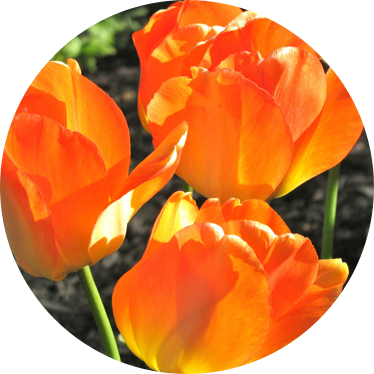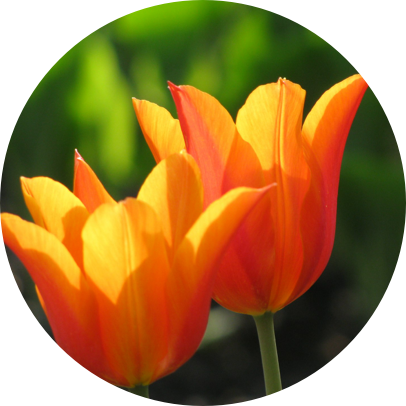
I planted 250 tulips that autumn and had many sleepless nights over the long, cold winter. I visualized endless channels of soil dug by voracious voles orchestrating fabulous bulb feasts. Nightmares about muted, muddy hues crept into my head. But, as the warmth of spring lured plants from their underground dormancy, the tulips grew very stately and tall. Their huge buttercup yellow bowls painted with scarlet-orange flames were so much more exquisite than I could ever have imagined. Their black interiors edged in gold made this cultivar especially captivating when backlit by the sun. The right color choice had been made and was evident by the photo snapping, finger-pointing drive-bys; smiling neighborhood walkers; and honking school bus drivers. Spring had arrived and it glowed opulent and orange.
Introduced in the US by John Scheepers back in 1951, Tulipa ‘Orange Bowl’
was my first Darwin hybrid. The following fall I planted T. ‘Daydream’ to fill in any gaps, since ‘Orange Bowl’ was unavailable. ‘Daydream’ proved to be just as magical with changing colors of soft apricot, warm orange and yellow, with an unexpected bonus – fragrance. They actually looked like creamsicles on sticks! Though the flowers were not as large
as ‘Orange Bowl’, they complimented each other perfectly. I also spiced things up with lily flowering T. ‘Ballerina.’ This award winner glows with
marigold-orange petals highlighted with scarlet flames. Feathered
lemon-yellow edges top off each petal. Fully open, ‘Ballerina’ flaunts a red interior and has a citrus-like fragrance. (See chart below for a list of popular orange tulips)
I used several tactics to encourage my tulips to perennialize. Before planting, I selected areas in my garden where soil had been amended with organic matter and drainage was good. I tried not to plant in areas where I grow annuals, since the annuals need irrigation all season and the bulbs prefer a drier soil. I planted my bulbs deep (8 to 12” using a power drill and bulb auger) to buffer them from severe weather and also to deter rodents. Depending on the size of the beds, viewing distance and overall scale of trees and shrubs, I grouped 10-20 bulbs together for optimum impact.
Although soil and drainage are critical to perennialization of tulips, I also followed a rigid schedule for fertilization. Recommendations from John Scheepers, one of the oldest and most prestigious flower bulb importers, include top-dressing both new and mature flower bulb plantings three times a year. Use a granular time release 4-10-6 fertilizer. Start in the early spring
when foliage first pokes through the soil, then fertilize again in the late spring or early summer just before the flowers start to die back. Finally, fertilize again in the fall to develop a healthy root system. Broadcast at a rate of one heaping teaspoon per bulb or as directed on the package. After planting new bulbs, gently tap down the soil, then top dress with fertilizer. Be sure to water plantings gently if no rain is expected within a week. Nutrients will be released slowly over time. Do not add fertilizer to the bottom of the planting hole. Fertilizer can burn the roots and cause stunted growth resulting in few or no flowers.
Over the years I have added many more bulbs to my spring garden. The bright yellow of Narcissus ‘King Alfred Improved’ looks spectacular with orange tulips, highlighting the subtle yellow colorations. Grape hyacinths
and purple alliums offer tantalizing contrast. I also experiment with splashes of color adding white, red and even pink tulips to my existing display for a welcoming spring surprise.
If perennials are your preference, try the very dependable and long blooming rockcress (Arabis alpina) in white or violet. It is sweetly scented, deer resistant and blooms profusely for 4 weeks or more. Use forget-me-nots, violets, columbine, siberian bugloss (brunnera) and Geranium phaeum ‘Samobor’ to bring in contrasting colors of blue and purple. Bright yellow can be added with leopard’s bane (doronicum) and several varieties of the drought tolerant epimediums. For a pastel palette of hardy early spring bloomers try lamium, bleeding hearts, hellebores, tellima, primroses and sweet woodruff. A refreshing bright green splash of color with amazing textures can be added with ferns. Some of my favorite early spring sprouting fiddleheads include lady fern (Athyrium filix-femina), ostrich fern (Matteuccia struthiopteris), maidenhair fern (Adiantum pedatum) and the spinulose wood fern (Dryopteris carthusiana). Hardy, low maintenance and deer/rabbit resistant, ferns are the queen of green in my garden.
Although orange can be a challenging color, especially in a spring garden, it is ultimately exhilarating when combined with complimentary and contrasting hues. It cries out the loudest for attention, while exuding a warmth and cheerfulness as it ushers in the spring. Finding the right tulip for my garden has been challenging, yet extremely gratifying. I look forward to the explosion of color every spring and the reaction it elicits.
© 2017 Gardens By Colleen. All rights reserved.








Tulipa ‘Daydream’
Tulipa ‘Orange Bowl’

Tulipa ‘Ballerina’
Plant 10-20 bulbs
together in groups
for maximum impact
Narcissus
‘King Alfred Improved’
behind Tulipa ‘Orange Bowl’
Sweet woodruff,
leopard’s bane
and lady ferns
mingle
with my tulips
Tulipa ‘Ballerina’
backlit by the sun
Tulipa ‘Orange Bowl’

by Colleen O’Neill Nice
Several years ago I began my search for the perfect tulip to compliment my spring garden. First, I desired a tulip that would perennialize. My strategy was to add new combinations every year that would accentuate the existing tulips and forgo the task of replanting hundreds of bulbs every fall. Second, I needed to choose a mid or late blooming cultivar. With unpredicable weather, I did not want heavy snow or late frost to sabotage my efforts. And lastly, I dreamed of a color that would coordinate with my existing plant palette, as well as partner with the terra cotta backdrop of my brick home.
So I started my research with the book “Tulips for North American Gardens” by Brent and Becky Heath. The Heaths, owners of Brent and Becky’s Bulbs for nearly 40 years, describe the Darwin hybrids as long stemmed, single, midseason bloomers. A cross between the Darwin tulips and Emperor tulips, the Darwin hybrids are among the most weather resistant. According to the Heaths, “We have seen many instances around the country...where these tulips have perennialized and bloomed faithfully for 15 to 20 years under good growing conditions. We have to admit that this group of true perennials – the regal giants of the tulip kingdom – are our favorites.” The Darwin hybrids produce enormous blooms lasting four to five weeks during long, cool springs. They grow 18 to 22” tall and are highly virus and disease resistant. Just the tulip that I was looking for!
Prior to making my cultivar selection, I called on my husband, an expert in color. Now I highly value my husband’s opinion and generally listen to his suggestions, but often go in a totally different direction. And this is precisely what happened with the tulips. He, being somewhat traditional, had visions of hundreds of flaming red tulips on tall arching stems. Clusters of petite amethyst muscari creating a royal carpet of contrast beneath. Well, he didn’t say it exactly like that, but you get the picture. I dreamed of something a bit more trendy, a color that was warm and bright and distinct. A color underused – for tulips.
So, I reread Christopher Lloyd ‘s book “Colour for Adventurous Gardeners.” Each chapter describes a color and the feelings it arouses within a garden. Lloyd explains that white appears “...cold, staring and assertive” while yellow emerges as “cheerful, stimulating... it lifts the spirits.” Pink is viewed as “harmonious and reassuring...the most feminine color,” continues Lloyd. Reading the book stirred my emotions and brought back memories of my experiences at Great Dixter back in 2002. The wonderful color combinations engineered by Lloyd and head gardener, Fergus Garrett, were not only mesmerizing, but deeply impassioned. I, too, wanted to design a spring garden that would arouse emotions.
On-line bulb sources:
Brent and Becky’s Bulbs
Dutch Gardens
John Scheepers
McClure & Zimmerman
Messelaar Bulb Company
Netherland Bulb
Van Bourgondien and Sons
Van Engelen Inc.
White Flower Farm
Printed in the Upstate Gardeners’ Journal, May-June 2011
Popular
Orange
Tulips
Name Color Fragrant Kind Flowering Period Height Zones
Apricot Beautysoft salmon, pale rose flamesyessingle early 14-16”3-7
Bestseller reddish pink to orange to salmonyessingle early 12-14”3-8
General de Wetsoft marigold orange with yellowyessingle early 14-16”3-8
Striped Bellonabuttercup yellow and orangenosingle early 18-24”4-9
Dillenburg brick orange with flush of yellowyessingle late 18-24”3-9
Orange Nassaubright orange scarlet nodouble (peony) early 12”3-7
Charming Beautyapricot with dusky apricot centernodouble (peony) late 18”3-7
Orange Princessnasturtium-orange with pink glowyesdouble (peony)late 14”3-7
Sensual Touchrich tangerine with fringed petals nodouble (peony)late 16-18”3-7
Annie Schilder warm orange with soft salmon edge yesTriumph mid-season 18”3-7
King’s Orange vivid dark coral with orange edges noTriumph mid-season 22”3-7
Prinses Irene bright orange with purple flamesyes Triumph mid-season 12-14”3-7
Tequila Sunrise yellow to golden, tangerine to ruby noTriumph mid-season 16-18”3-7
Ad Rem deep orange, yellow edged petals yesDarwin hybrid mid-late 20”3-7
American Dream pale yellow edged in red and apricot noDarwin Hybrid mid-late 22”3-7
Apeldoorn's Elite red, orange-yellow noDarwin hybrid mid-late24”3-8
Beauty of Apeldoorn orange-yellow-red striped noDarwin hybrid mid-late24”4-8
Daydream yellow to soft apricot orange yesDarwin hybrid mid-late20” 3-8
Orange Bowl yellow flowers with orange flames noDarwin hybrid mid-late20” 3-8 Ballerina yellow/orange/red, feathered petals yesLily Flowering late 22”3-7
Fokker Fan Fan bright orange with red flames yesLily Flowering late 16-18”3-7
Artist salmon-rose, purple, green markings noViridiflora late 14”3-8
Golden Artist rich golden orange with green noViridiflora late 14-16”3-7
Apricot Parrot bright apricot-coloured, pink striped noParrot mid-late 24”3-8
Orange Favourite bright orange marked with green yesParrot mid-late 14”4-8
Salmon Parrot salmon, green, cream, yellow highlights no Parrot mid-late 20”4-7
Early Harvest orange scarlet with yellow center noKaufmannianaearly 8-10”3-8
Shakespeare red edged in salmon, yellow center noKaufmannianaearly 8-10”3-8
Cape Cod apricot, yellow, red, mottled foliage noGreigii mid-late 10-12”3-7
Professor de Monsseri persimmon-red tips, pale yellow edges no Greigii mid-late 12”3-7
Sweet Lady pink, red, orange; purple mottled foliage no Greigii mid-late 6-10”3-7
Juan orange, yellow, purple mottled foliage no Fosteriana early-mid 16-18”3-9
Orange Emperor carrot orange, yellow base no Fosteriana early 16-18”3-8
Orange Bouquet orange-red with yellow base no multi-floweredmid-late 20”3-8
Tangerine Beauty fire red with orange flames no Species late 8”5-8